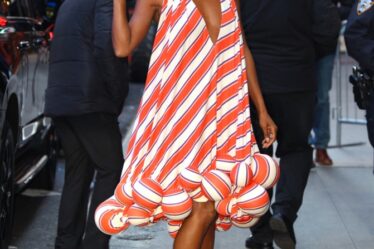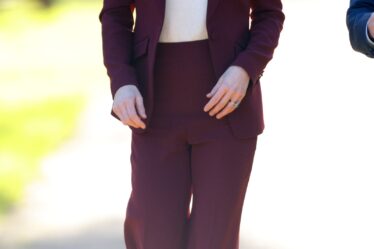
In May, Gucci released a campaign with the 22-year-old Italian tennis star Jannik Sinner featuring a Gucci-logoed bag on his shoulder, waving to an imagined audience. Four words splayed across the photograph, which was a nod to him becoming the first competitor to carry a non-white bag onto the court at Wimbledon last year: “Gucci is a feeling.”
Also front and centre, though, was the Nike swoosh on Sinner’s hat.
A few weeks later, it happened again: tennis champion Roger Federer sported On shoes and a Rolex Daytona in a Louis Vuitton campaign alongside one-time arch rival Rafael Nadal.
Luxury fashion brands are known for keeping tight control over where and how their products appear. They place strict full-look requirements on magazine editors and the influencers they invite to their runway shows. So why would Gucci and Louis Vuitton cede space to brands like Nike and Rolex in ads?
Likely they didn’t have any other choice.
Sinner has a $158 million, 10-year deal with Nike. Federer has been a Rolex ambassador for over two decades and is a part-owner of On. Typically, those sorts of partnerships come with exclusivity clauses and obligations, which means that when fashion brands want to work with athletes, it often means dealing with other brands.
This is usually a manageable task: athletes’ performance wear deals often contain carve-outs that allow them to promote non-competitive brands, and there’s little product overlap between what an athlete is showcasing (suits for Gucci, sneakers for Nike). Still, working with athletes sometimes means that fashion brands must be willing to share the spotlight, even in their own advertising. As fashion brands are increasingly looking to tap the power of sport, they must contend with an extra layer of complication in inking deals and the growing sway top athletes hold in today’s cultural landscape.
“Athletes are the celebrities of celebrities,” said Tom Chapman, partner and agent, WME Sports.
Obligations and Opportunities
Working with athletes didn’t come naturally for fashion initially, said Roman Di Somma, head of international talent at CAA Sports.
“Fashion houses couldn’t understand how an athlete’s world works … they thought they could take these athletes and brand them head to toe and they couldn’t understand why an athlete had to shoot wearing a Nike or an Adidas T-shirt,” said Di Somma. “It caused many deals to fall through.”
Athletes — or those with enough cachet to attract fashion brand partnerships — typically have preexisting sponsorship deals in categories like performance wear, watches, equipment, beverage and cars. A player’s appearance gets divided up among brands, so “it’s almost like you’re buying parts of the athlete,” said Tony Wang, founder of luxury consultancy Office of Applied Strategy. Partnerships can contain rules about not just what to wear, but how to wear it, alongside stipulations requiring attendance at a certain number of tournaments and events.
“It will say, ‘You have to wear this type of clothing and only these sneakers. If you’re wearing a suit it doesn’t count, if you’re wearing sneakers with a suit, that counts,’” said Kevin Masuda, partner at law firm Gibson Dunn, who has who has worked on deals for LeBron James and Louis Hamilton.
What an athlete is allowed to do is dictated by their biggest partner, both because it’s baked into the contract and because athletes are keen to keep them happy. Nike will have a say in what brands are defined as competition or what interferes with their exclusivity; it likely has approvals on any campaign imagery it ends up appearing in, said Masuda.
And as fashion brands experiment with sportswear and sportswear brands embrace lifestyle products, the lines of who is considered a competitor are more blurry. It’s often up to athletes and their agents to navigate the system. In any grey area, “it’s all in how the contracts are written and the power of talent,” said Doug Shabelman, chief executive of Burns Entertainment, which matches talent with brands.
What’s Next
As more brands look to work with them, top athletes’ negotiating power is growing, said Masuda. The nature of the deals they’re interested in is changing too: Many are opting to work with smaller, unexpected brands that align with their values or offer them a stake and greater opportunities for collaboration.
Just this week, Skechers signed its first WNBA player, Rickea Jackson, and Miami Dolphins wide receiver Odell Beckham Jr. launched a loungewear campaign with Lululemon. Tennis superstar Roger Federer, Olympic gymnast Simone Biles and American tennis player Taylor Fritz have all split from Nike in recent years. Federer now works with Uniqlo as well as On, while Biles chose Athleta because “they stand for everything I stand for,” she told the Wall Street Journal after signing in 2021. Last year, Fritz signed a head-to-toe deal with German fashion label Hugo Boss because it baked in the opportunity to attend brand events and model in global campaigns, said Chapman, who represents Fritz.
Money is no longer the best indicator of a good deal, said Ambre Stanford, CAA’s head of social impact. Athletes want to curate a compelling mix of partners who could help build their public profiles in adjacent industries, said Brittany McCallum, VP of basketball marketing at agency Klutch Sports.
Fashion is often at the top of the list. Athletes are popping up more at fashion week and in campaigns; brands — from high fashion to beauty and jewellery — are sponsoring teams and whole leagues. In recent years, beauty brand Glossier and haircare line Mielle Organics have become sponsors of the WNBA, while Prada partnered with China’s Women’s National Football team. Loro Piana is the official outfitter of Italian football club Juventus.
“[Fashion] partnerships probably pay the least but can give you the most cultural relevance from a marketing standpoint,” said Chapman.
Pairing fashion and sports brands together has potential for both parties. In Sinner’s Gucci campaign, he appeared how fans are used to seeing him — dressed in Nike — leveraging a big, real-life moment, which is when sports marketing works best, said Wang.
”All brands want powerful images. The problem with a fashion image is you have to work hard to create a story,” said Wang. “With sports the story is made for you, and reality is the ultimate art director.”



